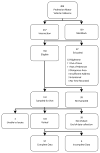Pedestrian signalization and the risk of pedestrian-motor vehicle collisions in Lima, Peru
- PMID: 24821630
- PMCID: PMC4097079
- DOI: 10.1016/j.aap.2014.04.012
Pedestrian signalization and the risk of pedestrian-motor vehicle collisions in Lima, Peru
Abstract
Safe walking environments are essential for protecting pedestrians and promoting physical activity. In Peru, pedestrians comprise over three-quarters of road fatality victims. Pedestrian signalization plays an important role managing pedestrian and vehicle traffic and may help improve pedestrian safety. We examined the relationship between pedestrian-motor vehicle collisions and the presence of visible traffic signals, pedestrian signals, and signal timing to determine whether these countermeasures improved pedestrian safety. A matched case-control design was used where the units of study were crossing locations. We randomly sampled 97 control-matched collisions (weighted N=1134) at intersections occurring from October, 2010 to January, 2011 in Lima. Each case-control pair was matched on proximity, street classification, and number of lanes. Sites were visited between February, 2011 and September, 2011. Each analysis accounted for sampling weight and matching and was adjusted for vehicle and pedestrian traffic flow, crossing width, and mean vehicle speed. Collisions were more common where a phased pedestrian signal (green or red-light signal) was present compared to no signalization (odds ratio [OR] 8.88, 95% Confidence Interval [CI] 1.32-59.6). A longer pedestrian-specific signal duration was associated with collision risk (OR 5.31, 95% CI 1.02-9.60 per 15-s interval). Collisions occurred more commonly in the presence of any signalization visible to pedestrians or pedestrian-specific signalization, though these associations were not statistically significant. Signalization efforts were not associated with lower risk for pedestrians; rather, they were associated with an increased risk of pedestrian-vehicle collisions.
Keywords: Built environment; Pedestrian signals; Pedestrian-motor vehicle collisions; Pedestrians; Peru; Traffic signals.
Copyright © 2014 Elsevier Ltd. All rights reserved.
Figures



Similar articles
-
Environmental measures to improve pedestrian safety in low- and middle-income countries: a scoping review.Glob Health Promot. 2024 Dec;31(4):44-55. doi: 10.1177/17579759241241513. Epub 2024 May 8. Glob Health Promot. 2024. PMID: 38716695 Free PMC article.
-
Multilevel models for evaluating the risk of pedestrian-motor vehicle collisions at intersections and mid-blocks.Accid Anal Prev. 2015 Nov;84:99-111. doi: 10.1016/j.aap.2015.08.013. Epub 2015 Sep 1. Accid Anal Prev. 2015. PMID: 26339944 Free PMC article.
-
The walking environment in Lima, Peru and pedestrian-motor vehicle collisions: an exploratory analysis.Traffic Inj Prev. 2015;16(3):314-21. doi: 10.1080/15389588.2014.930830. Epub 2014 Nov 10. Traffic Inj Prev. 2015. PMID: 24950345 Free PMC article.
-
Bus stops and pedestrian-motor vehicle collisions in Lima, Peru: a matched case-control study.Inj Prev. 2015 Apr;21(e1):e15-22. doi: 10.1136/injuryprev-2013-041023. Epub 2013 Dec 19. Inj Prev. 2015. PMID: 24357516 Free PMC article.
-
State-of-the-art review: preventing child and youth pedestrian motor vehicle collisions: critical issues and future directions.Inj Prev. 2021 Feb;27(1):77-84. doi: 10.1136/injuryprev-2020-043829. Epub 2020 Nov 4. Inj Prev. 2021. PMID: 33148798 Free PMC article. Review.
Cited by
-
Road Traffic Injuries and the Built Environment in Bogotá, Colombia, 2015-2019: A Cross-Sectional Analysis.J Urban Health. 2024 Aug;101(4):815-826. doi: 10.1007/s11524-024-00842-2. Epub 2024 Apr 8. J Urban Health. 2024. PMID: 38589673 Free PMC article.
-
Environmental measures to improve pedestrian safety in low- and middle-income countries: a scoping review.Glob Health Promot. 2024 Dec;31(4):44-55. doi: 10.1177/17579759241241513. Epub 2024 May 8. Glob Health Promot. 2024. PMID: 38716695 Free PMC article.
-
Urban landscape and street-design factors associated with road-traffic mortality in Latin America between 2010 and 2016 (SALURBAL): an ecological study.Lancet Planet Health. 2022 Feb;6(2):e122-e131. doi: 10.1016/S2542-5196(21)00323-5. Lancet Planet Health. 2022. PMID: 35150622 Free PMC article.
-
Design of a Location-Based Case-Control Study of Built Environment Risk Factors for Pedestrian Fatalities in the U.S.Am J Epidemiol. 2024 Oct 11;194(7):1976-83. doi: 10.1093/aje/kwae377. Online ahead of print. Am J Epidemiol. 2024. PMID: 39393821 Free PMC article.
-
Evidence From the Decade of Action for Road Safety: A Systematic Review of the Effectiveness of Interventions in Low and Middle-Income Countries.Public Health Rev. 2022 Feb 21;43:1604499. doi: 10.3389/phrs.2022.1604499. eCollection 2022. Public Health Rev. 2022. PMID: 35296113 Free PMC article. Review.
References
-
- Bradbury K, Stevens J, Boyle L, Rutherford S. To go or not to go. Transportation Research Record: Journal of the Transportation Research Board. 2012;2299:174–179.
-
- Carmeli E, Coleman R, Omar HL, Brown-Cross D. Do we allow elderly pedestrians sufficient time to cross the street in safety? Journal of Aging and Physical Activity. 2000;8 (1):51–58.
-
- Chadda HS, Schonfeld PM. Are pedestrians safe at right-turn-on-red intersections? Journal of Transportation Engineering-Asce. 1984;111 (1):1–16.
-
- Chen L, Chen C, Ewing R, Mcknight CE, Srinivasan R, Roe M. Safety countermeasures and crash reduction in new york city—experience and lessons learned. Accident Analysis & Prevention. 2013;50 (0):312–322. - PubMed
Publication types
MeSH terms
Grants and funding
LinkOut - more resources
Full Text Sources
Other Literature Sources

